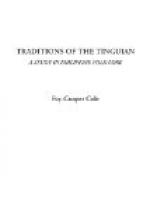[86] Rare beads.
[87] Larger beads than oday.
[88] Shallow wells are dug in the sands, near to the river.
[89] See p. 17, note 3.
[90] It was so long that it dragged.
[91] i.e., it was so small. The idea that roosters produce unusually small eggs is still held. The same conception is found in Javanese folk-lore. Here the “rooster’s egg” or its substitute—the Kemiri nut—is placed in the granary to cause an increase in the supply of rice. Bezemer, Volksdichtung aus Indonesien, p. 29, (Haag, 1904).
[92] See p. 17, note 3, for similar incidents in other Philippine tales, also from Borneo and India.
[93] The illuminating power of beauty receives frequent mention. Similiar references are met with in Malay legends and Indian tales. See Tawney, Katha Sarit Sagara, p. 121 ff. (Calcutta, 1880.)
[94] The meaning of this passage is not clear.
[95] See p. 17, note 3.
[96] See p. 10, note 1.
[97] See p. 9.
[98] See p. 18, note 2, for similar incidents.
[99] This would have been a sign that the child wished to go to its father.
[100] See. p. 11 ff.
[101] Certain varieties of bamboo and reeds.
[102] See p. 13.
[103] See p. 13, note 1.
[104] The rice used in this ceremony is pounded in a certain manner, by many women who sing as they work.
[105] See p. 18.
[106] See p. 13, note 2.
[107] See p. 12.
[108] Like presents, or others of equal value, are generally given in return.
[109] A dance held at the gate of the town, on the great day of this ceremony. During the dance rice and water are thrown on the visitors.
[110] This was a sign that they were related. In this case the quids of the young people went to those of their fathers.
[111] They had not yet paid the customary marriage price for the girl.
[112] See p. 6.
[113] Copper gong.
[114] A white and a black strip of cloth which the dancers carry in their hands. When the cloth is given to a person he is thus invited to dance.
[115] Kanag was the baby born from Aponibolinayen’s finger. Mentioned earlier in story.
[116] Names of different kinds of jars.
[117] Poles on which the heads of enemies are displayed.
[118] The alan are lesser spirits. See p. 14.
[119] See p. 18, note 1.
[120] See pp. 12-13.
[121] A powerful spirit.
[122] The head man of a Tinguian village.
[123] See p. 14.
[124] Algaba is renamed Aponitolau.
[125] See p. 11.
[126] A big bird.
[127] A bad sign. See p. 19, note 1 for omens.
[128] Sugar cane rum.
[129] The groom’s gift.
[130] Lesser spirits.




